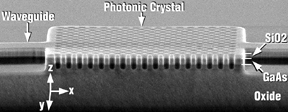ALBUQUERQUE, N.M. — A tiny bar that in appearance resembles cheesecloth has bent infrared beams with very little loss of light in laboratory experiments at the Department of Energy's Sandia National Laboratories. The bar is fabricated from gallium arsenide.
The effect, published in the Oct. 26 issue of Nature and in the Sept. 1 Optics Letters, opens the possibility that the simple, inexpensive, essentially two-dimensional technique can drastically reduce the energy needed to start and operate a laser. Most energy input for lasers merely compensates for the large amount of light ordinarily dispersed uselessly in the lasing process.
Also, the cheesecloth-like structure can be considered essentially a wire for light, because the holes' premeditated size and periodic placement create a structure that blocks most light waves while transmitting those in a selected band of wavelengths that can navigate that geography.
Because of the very small light loss, the technique offers the potential of ultimately replacing electronic chips with faster, cooler photonic chips.
The technique could be used to combine light with electrons in a single chip. It also could be used to relay as well as change the direction of optical signals coming through telecommunication lines.
"Many people have realized the value of such a structure," says lead researcher Shawn Lin. "The problem has been, how do you build it?"
The perforated two-dimensional gallium arsenide shape of [Sandia's] Shawn Lin research team has proven unusually successful in bending infrared light with little loss.
A two-dimensional photonic crystal
The cheesecloth in scientific terms is referred to as a two-dimensional artificial crystal that conducts light — a two-D photonic crystal. The placement of holes substitutes in the photonic crystal for the spaces between molecules in real crystals. However, while natural crystals are restricted by their prearranged molecular spacing to permit only certain wavelengths of light to pass through them, researchers can vary the spacing of artificial crystal components, thus allowing any frequencies (within tool limits) to pass.
Built of gallium arsenide without metallic components, the crystals have little measurable intrinsic loss or distortion as they guide infrared light around sharp corners.
While the same researchers had earlier created three-dimensional silicon photonic crystals that bend light with little loss, two-dimensional crystals are cheaper and far easier to build.
The problem was that it was thought light would easily escape out the top and bottom of an essentially two-D structure. Sandia researchers got around that problem by capping the structure with silicon oxide on top and aluminum oxide on bottom. The cladding provides a large difference in the idex of refraction and dramatically improves the ability of researchers to keep light traveling within the central portion of gallium arsenide.
The crystal itself is of gallium arsenide and is "easy to make," says Lin, who with Sandia researcher Edmond Chow led the project. "One can have the laser and guiding element in the same chip. There is signal binding and switching, all in one place."
The hard part of the problem is to build the structure without it cracking, and then testing it, says Lin.
The structure resembles a narrow cross-section of a beehive with cell centers spaced at 416 nanometers, with holes of only 200 nanometers made by electron beam lithography.
A puzzle
The cladding's refractive index is higher than the refractive index of the material it encloses, thus preventing light from escaping from gallium arsenide. One might wonder how the cladding keeps the light stable as it passes through holes, since the refractive index of air is lower than the refractive index of semiconductors. (A higher refractive index prevents light from entering a substance.) The problem vanishes because the distance across the hole is so small that quantum interference effects come into play, and the light merely moves to the next confined substructure.
The cladding process was pioneered at Sandia as part of its groundbreaking VCSEL (vertical cavity stimulated emission laser) research work.
Scientists at MIT calculated dimensions of the structure.
The ongoing research is paid for by Sandia's Laboratory-Directed Research and Development program.
Mario Pedraza
Electrónica del Estado Sólido
Sección 2
Electrónica del Estado Sólido
Sección 2

Fuente: http://www.sandia.gov/media/NewsRel/NR2000/cheese.htm
ResponderEliminar